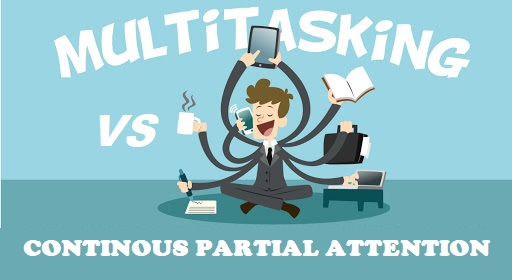
The Story So Far (Background):
In the second half of the last century, the Information and Communication Technologies (ICT) influenced all social structures so much deeply that the impact has created a gap in between the lifestyles of generations and their view of life. Thus, two groups occurred: the digital natives growing with technology and the digital immigrants struggling to keep up with this technology.
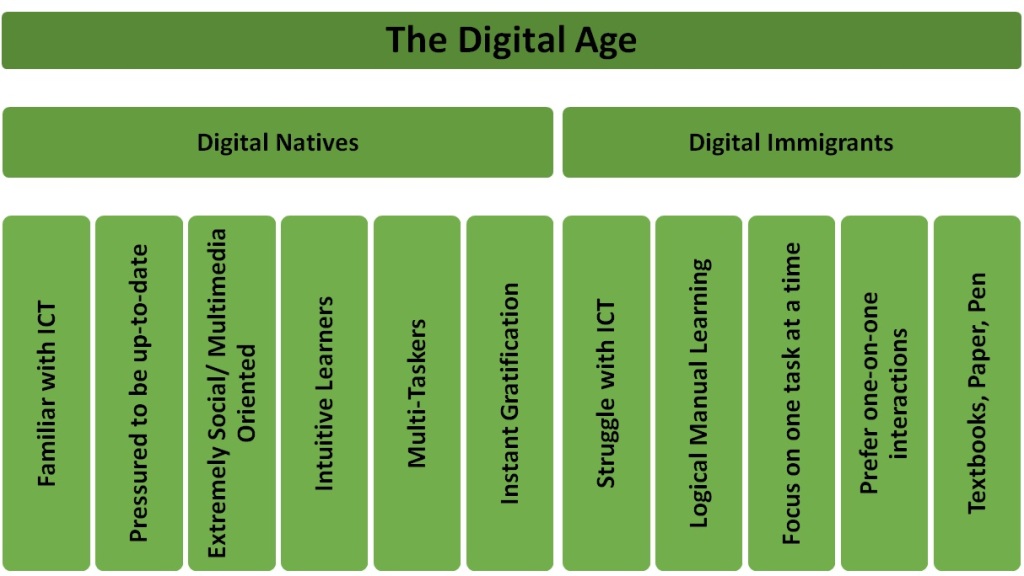
In this techno-culture, the presence of the physical and digital world can overlap each other and creates a “hybrid space”, where one no longer needs to go out of the physical space to get in touch with digital environments. The hybrid space is where the boundaries are blurred and where it is hard for people to determine the distinction between physical and virtual spaces. Digital natives are constantly connected and prefer to progress by randomly jumping from one place to another in modules rather than linear progression. The most prominent behavioural differences are:
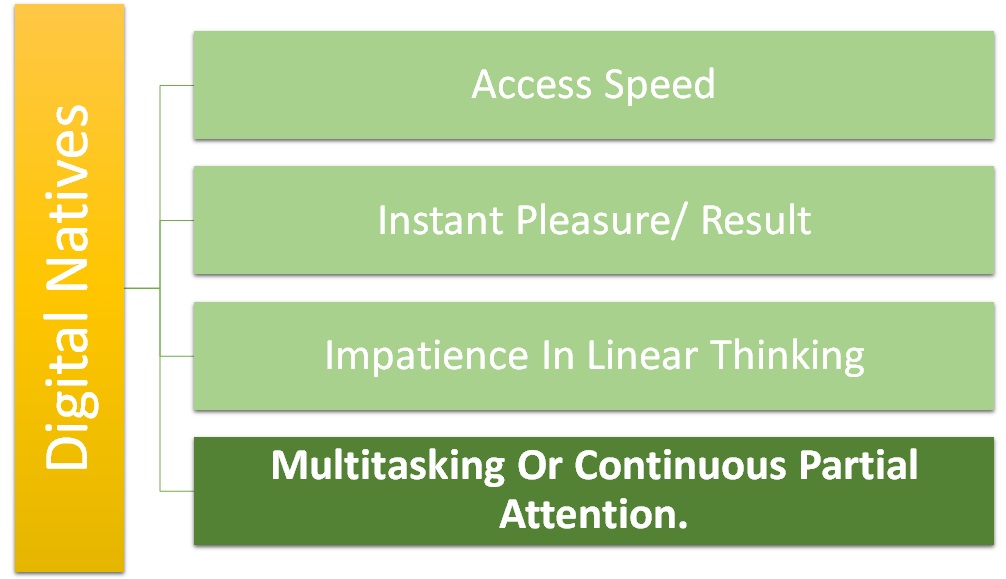
Multitasking
It is now very common for people who are preparing their projects on the computer and who, at the same time, go on checking their e-mails and instant messages and chatting on facebook and concurrently join in conservation with friends next to them. For this reason, the concept of multitasking allows fulfilling two or more tasks simultaneously such as making a phone call or checking e-mails while doing homework at the same time. In multitasking, it is important not only the ability to take the control and to focus one’s attention, but also the need for what to pay attention to and how much attention to pay is important.
It is driven by a conscious desire to be productive and efficient. Studies show that it is impossible to focus on more than one task. Therefore, multitasking often results in a high error rate.
Continuous Partial Attention (CPA)
Continuous Partial Attention (CPA) has occupied the present-day agenda of cognitive psychology, communication and education. This concept is referred to as the situation in which the individual does not focus on one thing in reality while he or she is engaged in and follows everything. For instance, the individual watches email notifications, tries to talk to his or her children and chat at the same time. In this case, because the individual is under an interaction bombing, he/she can only focus on each of these interactions, partially.
CPA is an automatic process that enables people to simultaneously pay attention to several sources of information, whilst scanning for relevant information. It allows people to shift from superficially concentrating on a lot of information to focusing on highly relevant information during a short attention span.
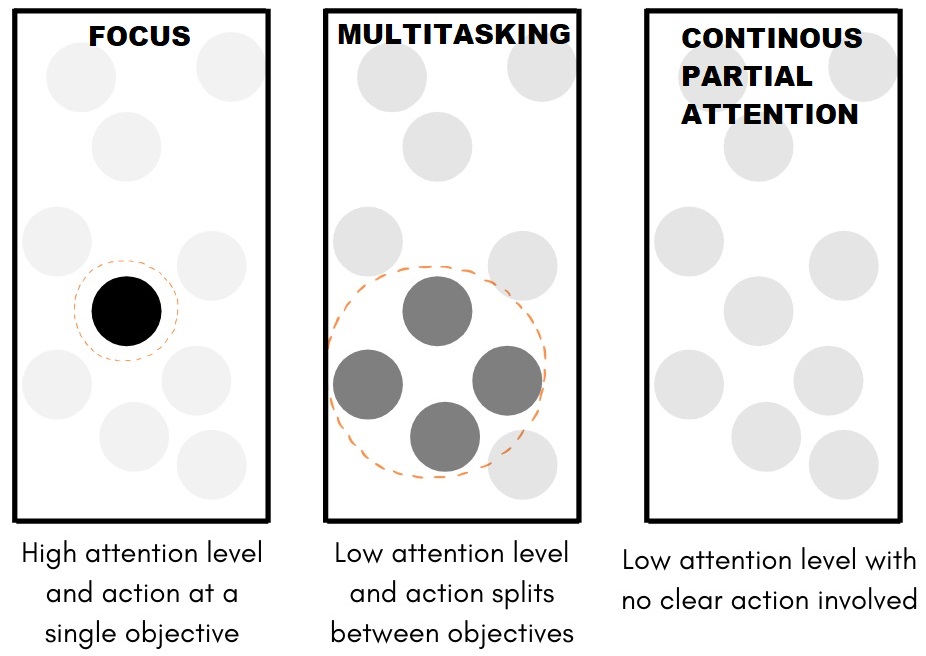
Difference between Multitasking and Continuous Partial Attention
They’re sometimes used interchangeably, but the terms “multitasking” and “continuous partial attention” are vastly different in terms of learner behaviour—especially for eLearning purposes. Natural human behaviour dictates how your learners react to certain material, and in a world where time is a precious commodity, organizations must decide exactly how they want learners to experience and absorb information.
We all know the pro multitasker: She can do more than one thing at a time, and her goal is always efficiency and getting things done. Multitaskers are focused on checking off boxes and to do so, such as checking email while eating lunch or taking call notes while doing research. Multitaskers are driven by results and task completion, which can sometimes result in a lack of quality.
A contrast to that behaviour, CPA means paying attention to multiple things at once; not necessarily completing tasks. You’ve probably engaged in continuous partial attention when you walk on the treadmill while listening to a podcast, sent a text message while sitting in a movie theatre, or laid in bed and gone over the latest sales numbers with a late-night TV show in the background. CPA taps into human nature: We crave instant satisfaction and being able to pay attention to a couple of things at once and receive automatic feedback makes us feel good.
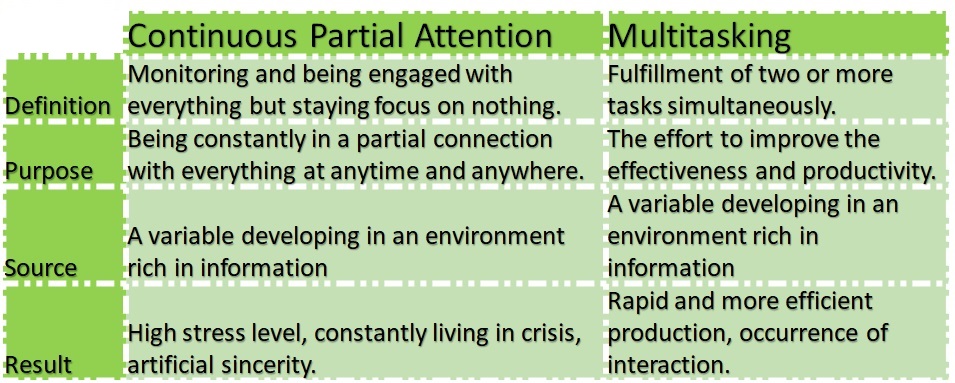
Implications in Business & Management:
The concept of multitasking implies the fulfilment of two or more tasks simultaneously.
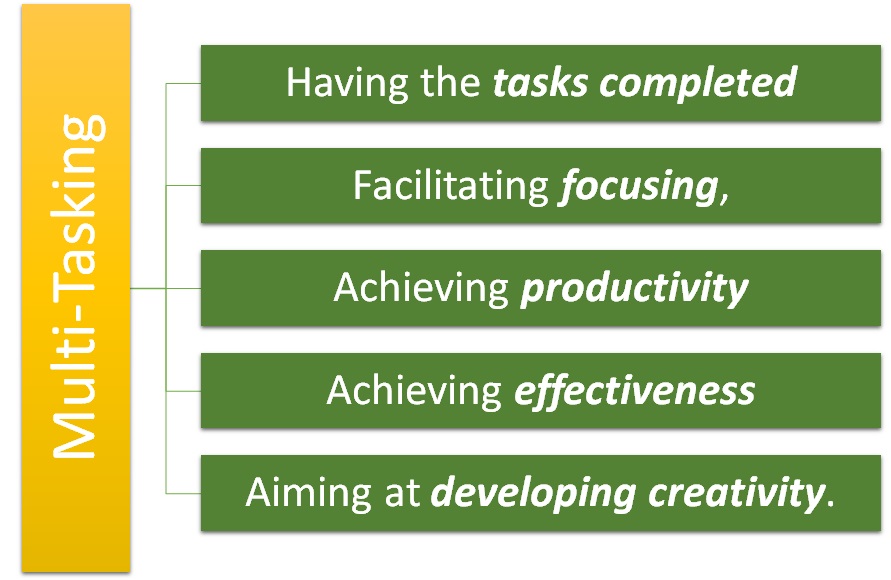
However,CPA is a concept that expresses the state of being in communication and interaction with everything but truly staying focus on nothing. CPA is something similar to being aware of many things at the same time: drawing our attention to more urgent alerts like a new e-mail notification or the bell of a ringing phone. When CPA is preserved, the perceived control and the eigenvalue feelings are doomed to collapse at some point because our brain, in the long term, is not shaped to follow such observation.
Therefore, CPA is considered a focusing problem which has been caused by today’s information and communication technologies and which could influence almost every phase of daily lives of individuals. The radical transformation which occurred towards digital media as communication tools, has created a profound impact on the lifestyles of individuals. The generation, which adheres strictly to the digital world, has such facilities and advantages as multitasking; however, they face certain negative situations such as continuous partial attention.
CPA forms a high level of stress in the human brain. Therefore, individuals, addicted to the internet, have no time to react, focus on anything or decide thoughtfully; rather, they live in a permanent crisis and in anticipation of a new friend or of a new yet insincere message. This situation may become irresistible after a while. Therefore, digital natives should enhance their multitasking experiences instead of CPA regarding technology use by developing their self-control and self-regulation skills under the influence of cognitive overload.
Steps to Combat Continuous Partial Attention Syndrome:
Turn off notifications.
Whether its the desktop computer at your workplace or the smartphone you always carry with you, for the love of god, turn off your notifications. That constant dinging, buzzing, and vibrating whenever something happens on Facebook or you get an email is contributing to your continuous partial attention disorder. Nothing’s so important that you should be continuously distracted all day long—have people call you if its an emergency.
Build a routine.
Consistency breeds creativity. Having a set time and place for each task (and timeboxing your activities) let’s you off the hook when it comes to “always checking in.” When you know that you check and respond to emails between 4 P.M. and 5 P.M., you are not stressing about them all through the afternoon.
Practice galumphing.
Galumphing is doing something ordinary (taking a walk) in a frivolous, playful way (skipping, whistling a tune, doing cartwheels). A little bit of whimsy in your day-to-day life can refocus your attention and promote awareness. After all, it’s hard to check your smartphone while you’re doing a cartwheel.
Appreciate the moment.
The mundane, everyday moments of life are integral parts of your life too. Don’t fall into the trap of treasuring only the special, exalted times in your life—you will always be disappointed. Learning to be at peace with waiting is a special skill. Waiting offers an increasingly rare experience in our always-on world—a moment to pause and reflect.
Continuous Partial Attention (CPA) for eLearning:
The takeaway for understanding the difference between multitasking and CPA is this: organizations have to try harder to mold eLearning to their learners’ natural behaviors. Organizations have two choices: They can fight for that attention share with longer, more involved modules, or cater to waning attention spans by developing custom eLearning design and configuration that works in tandem with learner behavior.
The idea of page-turning eLearning might work for multitaskers, but ultimately results in lackluster information absorption. Instead of experiencing the material fully, it’s seen as just another item on the to-do list. Instead, integrating CPA delivery into existing modules in short, pithy, three-to-five minute bursts means learners can listen to an audio clip, play through a few levels on a gamified module, or watch a video, all while their attention is split. Relying less on eyes-on-the-screen eLearning means learners are more likely to tune in and, since they aren’t rushing to get through the module, actually absorb the information more effectively.
Content Curated By: Dr Shoury Kuttappa

